Calling everyone interested in learning more about the different types of hummingbirds -you are in the right place!
There are more than 360 different types of hummingbirds – join us to find out more about these tiny iridescent birds that flitter like jewels through the air.
Our hummingbird guide is easy to read and includes plenty of interesting hummingbird facts that will leave you in awe of these wonders of nature.
Get to know what hummingbird types to look out for in your area and how to identify each species.
There’s a lot more to hummingbirds than just their beauty; by knowing more about them, you can help them flourish.

What Is A Hummingbird?
Hummingbirds are types of birds that belong to a huge avian family called Trochilidae. Although it seems unbelievable, 360 types of hummingbirds have been described by scientists.
But while the extended hummingbird family may be enormous, individual hummingbirds are always tiny.
Even the biggest varieties weigh less than 0.7 ounces – although they seem like giants besides some of their cousins who can weigh as little as 0.07 ounces!
Some hummingbird types are so small that they are sometimes preyed on by praying mantises; fortunately, they are tiny athletes with plenty of maneuverability, so catching them isn’t easy.
Their wings flap so fast that even getting a clear photograph of a hummingbird can be challenging, but we promise you you will see many beautiful photos in this article.
Hummingbird Facts
Although there are lots of different types of hummingbirds, they all share some common characteristics. These include:
- They are all native to the Americas. While only a few species live in or visit the United States, hummingbirds occur more often in South America.
- They are the smallest birds on earth. Although there are other types of small birds, the first position for this title is taken by the bee hummingbird from Cuba, followed closely by the vervain hummingbird and esmeraldas woodstar.
- Hummingbird eggs are minuscule! Imagine baby birds that hatch from eggs that are smaller than peas. However, it is a cozy fit since hummingbird nests are sometimes only the size of a walnut shell.
- Hummingbirds appear to hover because they use the up and downstrokes of their wings. That means they could also fly upside down.
- If the weather gets too cold, hummingbirds can switch off. Unlike bears that hibernate for long periods, hummingbirds may only need to slow their metabolic functions for a few hours during a cool night or if food conditions are poor. This method of switching off their physiological engine for short periods is called torpor.
- Hummingbirds don’t only eat nectar. They hunt small insects and spiders to feed their young. Attracting fruit flies is a great way to support different types of hummingbirds in an area.
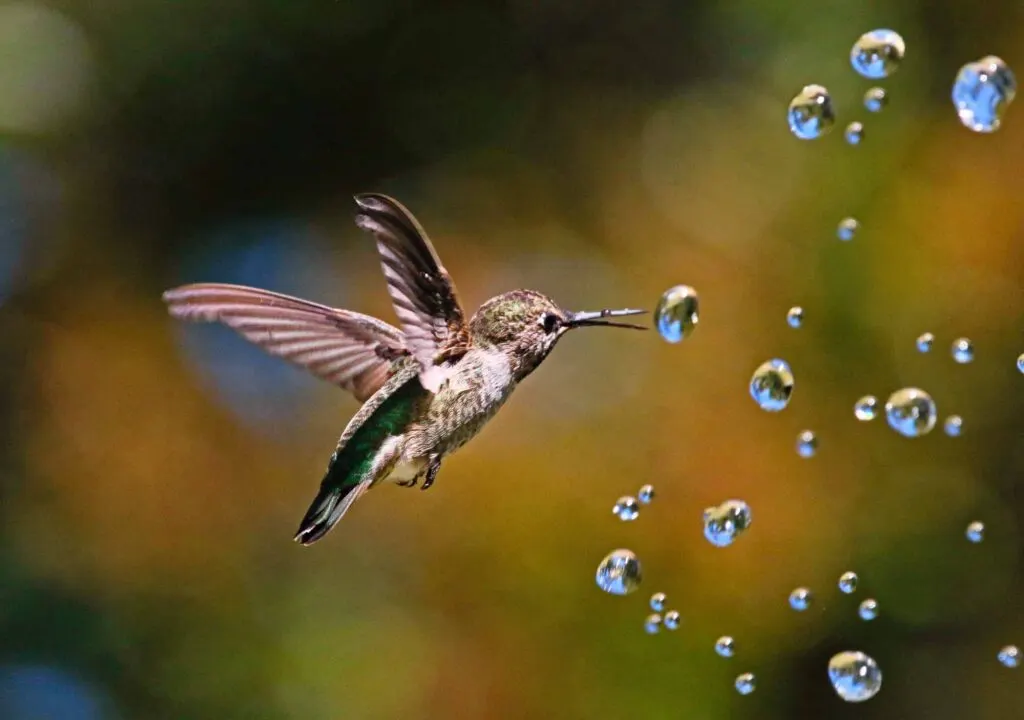
Hummingbird Types
Like all big extended families, there are smaller units within the main grouping. Scientists have divided different types of hummingbirds into six subfamilies.
There were seven subfamilies, but Eurotrochilus is a primitive, prehistoric variety that is long extinct, so we are only including the existing six on our list.
So, while the main overall family name for hummingbirds is Trochilidae, the 360 hummingbird types are split, and each one fits into one of the six subfamilies.
The long words can seem confusing, but they each have meaning and include species that are most closely related to each other.
Florisuginae
There are only four living species that fit into this subfamily.
They are collectively referred to as topazes and include the crimson and fiery topaz, white-necked, and black jacobins.
None of these occur in the United States, and you will need to travel to South America to catch a glimpse of a member of this subfamily.
Phaethornithinae
You will also need to visit South America to see a member of this subfamily which are known as hermits.
However, they are a much larger group and include 37 types of hummingbirds.
Polytminae
There are 29 species within this group, and they are informally known as mangoes.
You are unlikely to encounter members of this subfamily in North America as they prefer the tropical jungles of the southern continent.
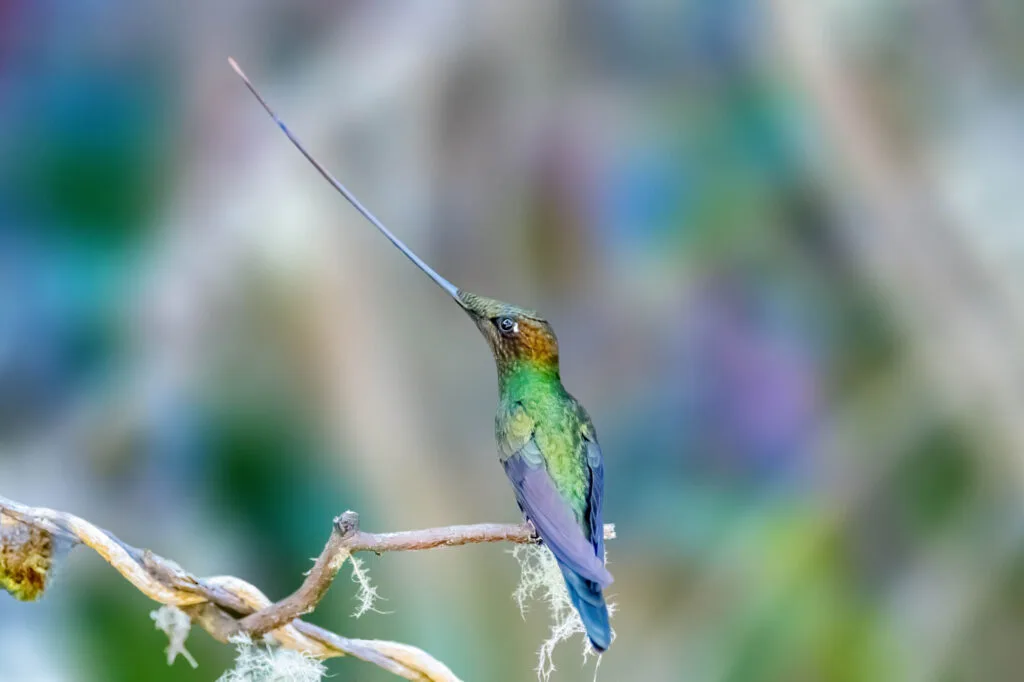
Lesbiinae
This subfamily of 33 hummingbird types is split into two groups called tribes; the brilliants and the coquettes.
Patagoninae
Patagoninae is the subfamily that contains the largest member of the hummingbird family. There is only one species in this subfamily which is the giant hummingbird.
Even though the giant hummingbird of western South America is a heavyweight compared to most of their relatives, they only weigh around 0.7oz.
Amazingly, although that is about the same size as a tiny sparrow, it is still about ten times heavier than a bee hummingbird.
Trochilinae
This is a large family that is divided up into what are commonly called the mountain gems (which contains 18 types of hummingbirds), the bees (the tiniest hummingbirds of which there are 37 species), and the largest group, which is the emeralds (115 species).
Bird watchers in the United States can look out for some members of this subfamily visiting flowers and feeders in their backyards.
One of the bee species, the ruby-throated hummingbird, is the most common hummingbird that visits the USA.
The exciting part about studying types of hummingbirds is that, according to BBC Wildlife Magazine, more kinds are being described each year. So keep your eyes peeled – you never know when you may see an unfamiliar flash of shimmering color which still needs to be listed.
18 Different Types of Hummingbirds You Can Spot
Now that we have covered the subfamilies of hummingbirds, it’s time to find out more about some types of hummingbirds that have unique characteristics or that you may see in your area.
1. Bee Hummingbird
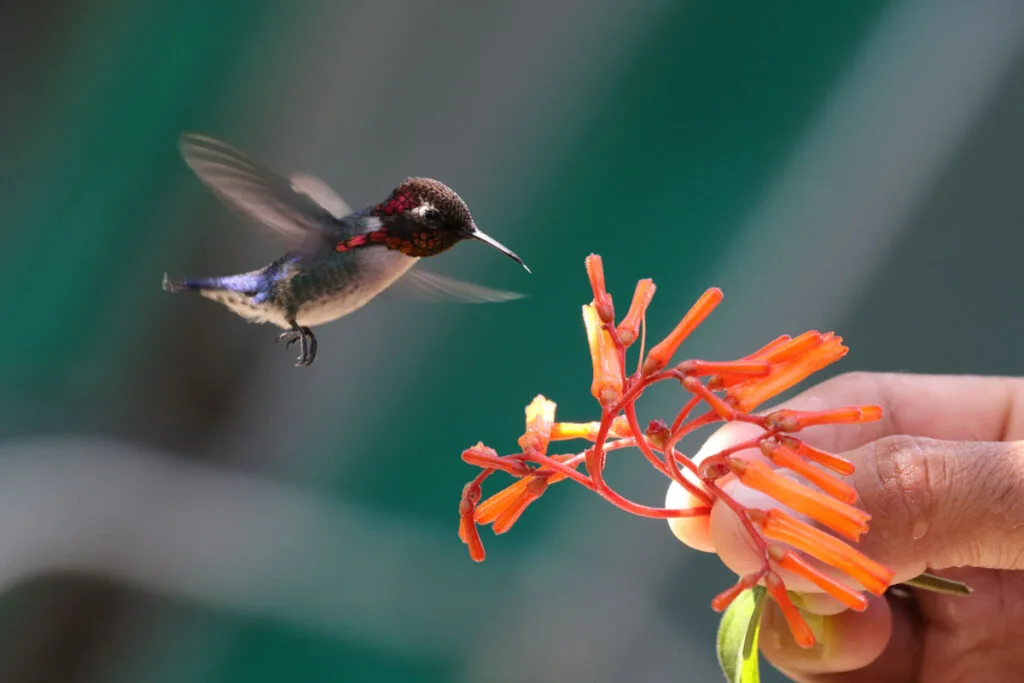
- Weight: Average weights: Females – 0.092oz and males – 0.069oz. As you can see, the females are slightly larger than the males. Individuals weigh less than a dime.
- Distribution: It is only found in Cuba
- Habitat: Bee hummingbirds are most often found in Cuba’s mogote areas. A mogote is a steep-sided tower-like hill surrounded by plains.
- Diet: Bee hummingbirds and plants in their native region are good examples of co-evolution. Nine of the ten plants that these tiny hummingbirds feed on only occur in Cuba. The hummingbirds depend on the plants for nectar, and the plants need the hummingbirds for fertilization.
As the world’s smallest birds, bee hummingbirds weigh no more than a dime.
Male and female bee hummingbirds are distinctly different in appearance. The males have shimmery greenish heads with red throats. The upper parts of their body are blue.
Females have a light color underside with an iridescent bluey-green which is lighter than the males.
Bee hummingbirds need to consume half their body weight daily to fulfill their energy requirements.
Their bodies are small, and because of their short tails proportionally, they appear plump and rounded.
During regular flights, bee hummingbirds beat their wings at 80 wingbeats per second. During courtships flights, this can increase to up to 200 beats every second!
2. Costa’s Hummingbird
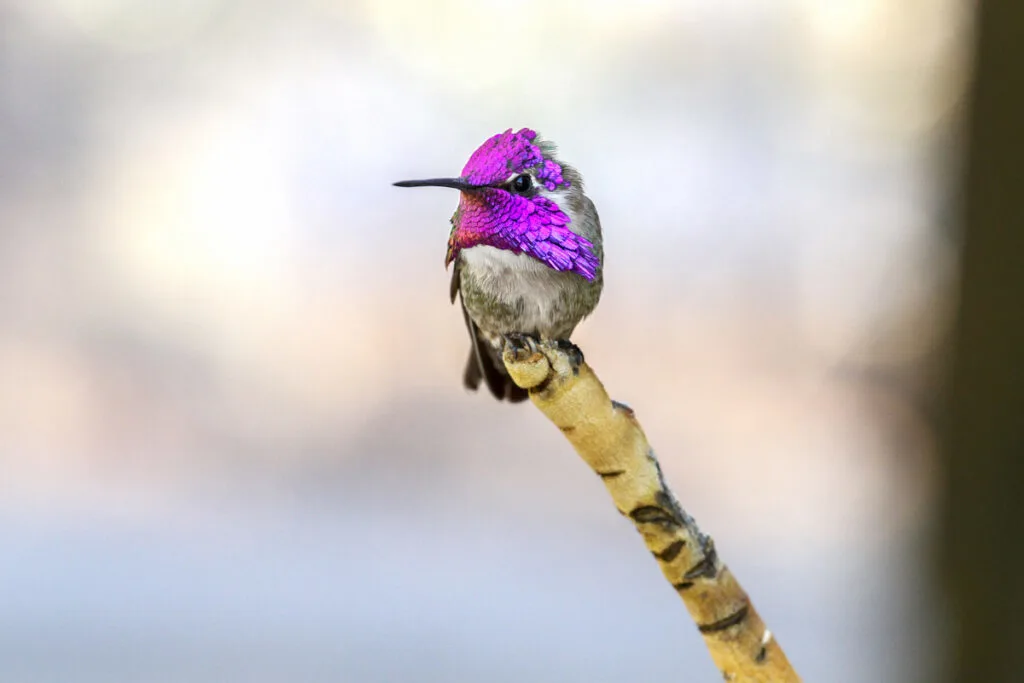
- Weight: 0.07 – 0.11oz. Females are slightly larger than males.
- Distribution: Southwest United States and Northwest Mexico
- Habitat: These desert birds inhabit arid landscapes that include bushy areas
- Diet: Nectar from desert flowers or insects caught during flight
Male Costa’s hummingbird is one of the colorful jewels of the hummingbird family. It has rich colors that include black, green, and purple.
Their distinguishing feature of males is their purple mantle that appears to drape down over their shoulders. Females are less showy and are better suited to camouflage during nesting.
Fortunately, Costa’s hummingbirds are not threatened; if you visit areas in their range, you will likely see one throughout the year.
They do move around in search of flowers, or if the temperatures drop too low, but on cold nights they usually just go into a state of torpor.
Costa’s hummingbird can breed with several other types of hummingbirds, including Anna’s hummingbird and broad-tailed hummingbirds.
It is, therefore, not impossible to see a hybrid Costa’s hummingbird.
3. Buff-Bellied Hummingbird
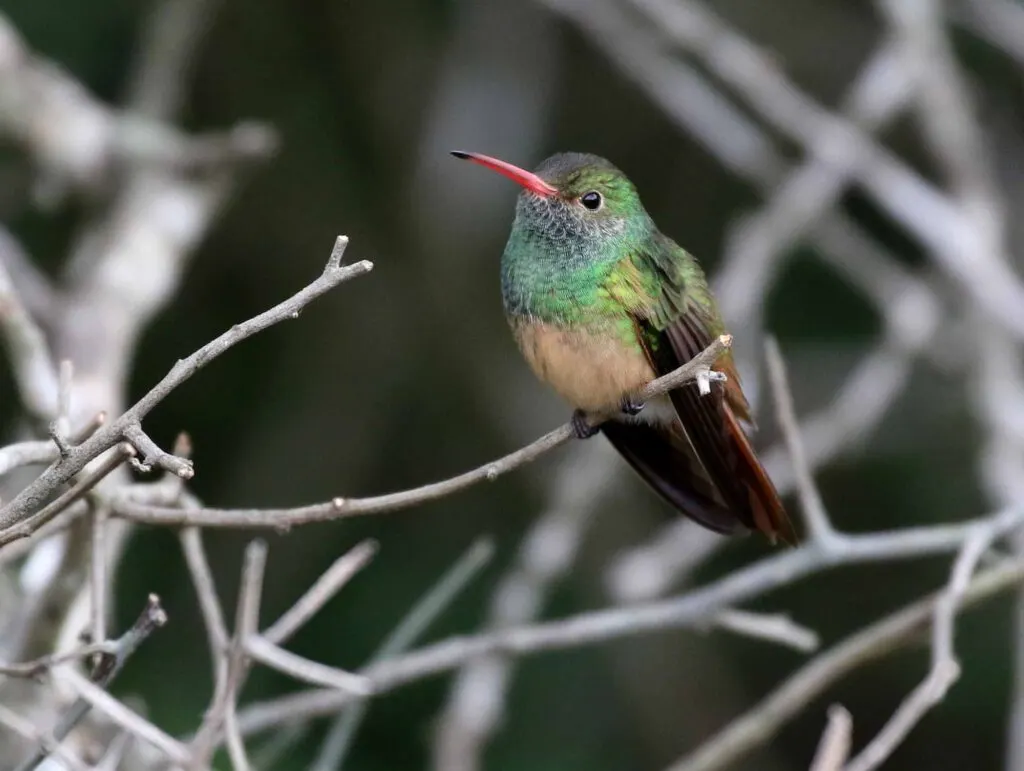
- Weight: 0.10 to 0.17 oz
- Distribution: Moves between Central and North America, namely between Guatemala and southern Texas.
- Habitat: Semi-open and dry forests, like forest edges and scrubby woodlands.
- Diet: Nectar and small insects
Buff-bellied hummingbirds are beautiful colorful birds belonging to the emeralds tribe Trochilini.
These medium-sized hummingbirds are species of hummingbird with distinct characteristics that differ between adult males and females.
Adult male buff-bellied hummingbirds have a vibrant and iridescent appearance with metallic bronze-green upperparts, bright green throat and chest, and a mix of cinnamon rufous and bronze-green on their tail feathers.
Adult females share a similar appearance but with less iridescence and different coloration on the bill and tail feathers.
Although their migration pattern hasn’t been determined yet, it seems they are sedentary in Mexico and Texas.
4. Blue-Throated Hummingbird
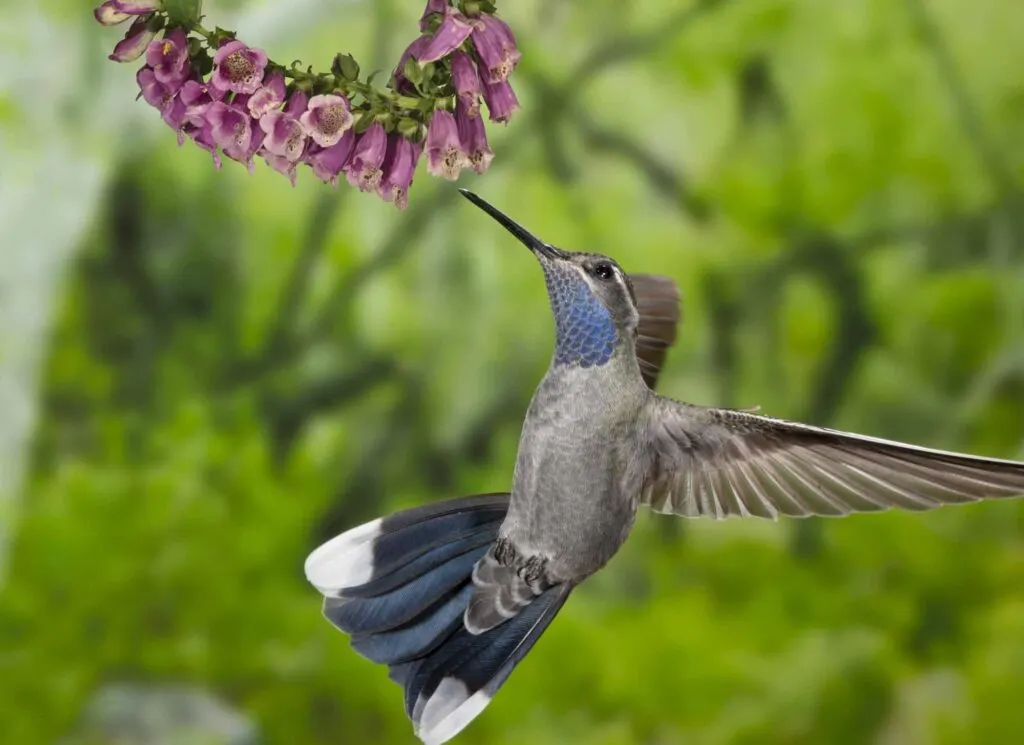
- Weight: 0.24 to 0.30 oz
- Distribution: Moves between northern Mexico and the southwest USA.
- Habitat: Wooded streams in canyons, pine oak forests, riparian forests, and mixed coniferous forests.
- Diet: Nectar and small arthropods
Of all the different types of hummingbirds found in America, the blue-throated hummingbird is the largest one, reaching up to 5 inches long.
Males are bronzy olive on the back, grayish on the chest, black tails with white tips, and iridescent cobalt to cerulean blue gorget. Their heads are dark gray with white ear stripes. Females have grayish feathers.
Despite being incredibly cute animals, these types of hummingbirds are aggressive and bold, often dominating other hummingbird species.
5. Anna’s Hummingbird

- Weight: 0.1 – 0.2 oz
- Distribution: Originally only northern Baja and southern California, the introduction of more flowering plants further north has allowed them to expand their range along the western coast and into southern Canada during summer.
- Habitat: Open scrubby areas and chaparral
- Diet: Nectar and insects. They also feed on exotic ornamental flowering plants.
Pink never goes out of style, and the bright, shimmering magenta head of male Anna’s hummingbirds is a rare wonder of nature.
They need sunlight to get the full flashy effect, and their heads appear dark when they are in shaded areas.
Female Anna’s hummingbirds are less colorful. They have shimmery light green backs, light gray undersides, and a dark gorget.
The striking bright color in male Anna’s hummingbirds is directly related to diet.
The more protein the bird consumes, the brighter its pink headgear will be, and of course, the more likely it is to attract the attention of females.
Not only that, but males will rise up about 130 feet and dive at 61 miles per hour to impress the females, making them one of the fastest birds in the world.
Anna’s hummingbirds were named after a French duchess. This is one type of hummingbird you won’t mistake for any other!
They are ready visitors at backyard bird feeders where the male’s unmissable pink coloration is unmissable.
6. Giant Hummingbird

- Weight: 0.63 – 0.85 oz
- Distribution: Along both sides of the Andes along the length of the mountain range in South America
- Habitat: High-altitude scrublands and forests during summer. They migrate to lower altitudes during winter.
- Diet: Mainly nectar from flowers. Females occasionally ingest calcium sources like soil, wood ash, or sand after the breeding season. In Chile, the birds frequently feed on specific varieties of columnar cacti.
The giant hummingbird is like a miniature celebrity within the hummingbird clan. Not only is it the largest hummingbird, but it is the only species representing the Patagoninae subfamily.
Giant hummingbirds are not particularly colorful. They are a dull yellowish brown, but their long straight bills, which are longer than their heads, give them a unique profile.
The males and the females of this species are identical.
The giant hummingbird is one of the only types of hummingbirds that occasionally glide while flying.
It has longer wings than most other hummingbird species, making this aerial maneuver possible.
Did you know? Of all the collective nouns for animals, the names for groups of birds are the most intriguing ones. A group of hummingbirds is called a charm or a bouquet of hummingbirds!
7. Calliope Hummingbird
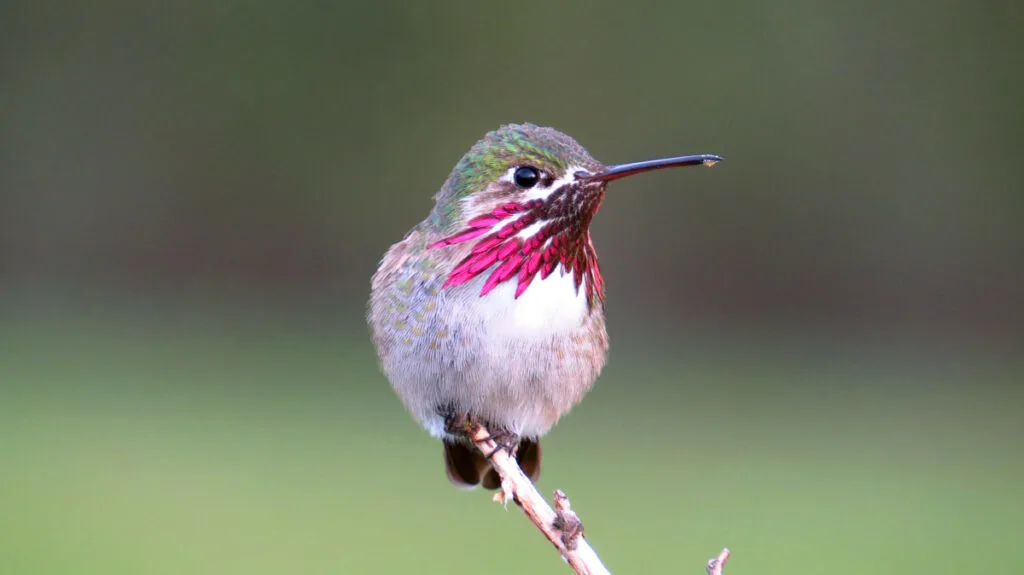
- Weight: 0.071 – 0.106oz
- Distribution: Western United States and Canada. The breeding area stretches from California to British Columbia. They migrate south into Mexico and Central America during winter.
- Habitat: Open shrublands – they tend to move around following seasonal flowers. They breed at high altitudes.
- Diet: They mainly feed on nectar from flowers. They also opportunistically catch insects while flying. They may hunt insects and spiders while feeding their young.
The bee hummingbird may be the smallest bird on earth, but the calliope hummingbird is the smallest bird that is native to North America.
They are truly magnificent little gems, and males can easily be identified by their eye-catching deep purple gorget.
These types of hummingbirds have glossy green feathers on the back and crowns with white underparts.
Adult males have wine-red to purple throats, while females and juveniles have a pinkish wash on the flanks.
Calliopes are American hummingbirds that are believed to be the smallest type of bird that travels the longest distances.
Namely, they travel over 5,000 miles to their wintering grounds and back to their breeding grounds.
Calliope hummingbirds are tiny travelers who appreciate nectar from tubular flowers that larger hummingbirds avoid and sugar water feeders en route, so look out for them at your backyard hummingbird feeders while they are moving through your area.
8. Brazilian Ruby Hummingbird
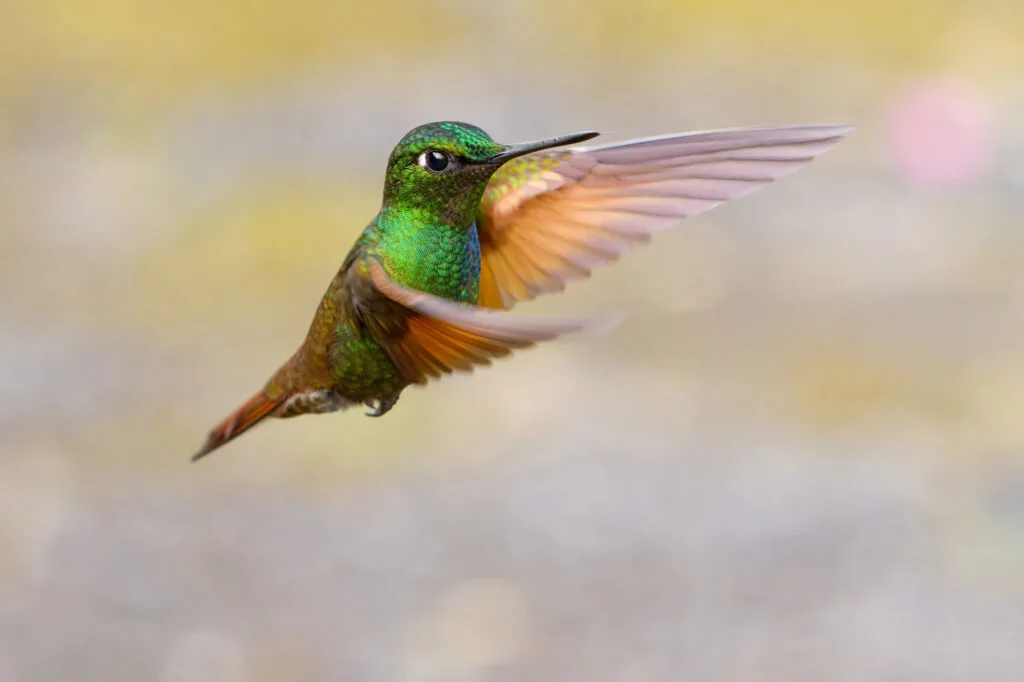
- Weight: Average weights: Males 0.25 – 0.32 and females 0.21 – 0.25. Females are slightly smaller than males
- Distribution: Only found in eastern and southeastern parts of Brazil
- Habitat: Parks, forests, banana plantations. More common at elevations below 1600ft
- Diet: Nectar from an assortment of flowering plants and trees. It utilizes all sources, including introduced varieties. It also eats small insects.
Male and female Brazilian rubies are very different in appearance.
While the females use subtle tones of peach with a pale green top, the males use a full palette of bright, shimmering colors, including green, bronze, and ruby red, to attract attention.
Both sexes have a characteristic white spot behind the eye.
Notably, in this type of hummingbird, the males are larger than the females.
Brazilian rubies feed readily at feeders and actively hunt insects using a method called hawking.
9. White-Eared Hummingbird
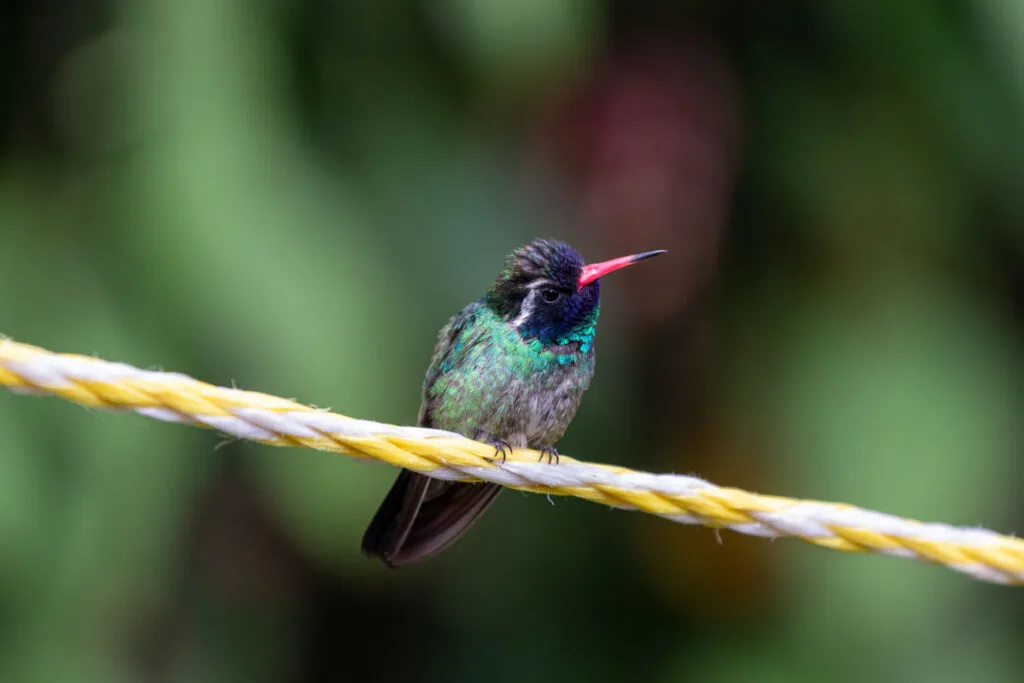
- Weight: Average weights: Males 13oz and females 11oz
- Distribution: Mexico and Central America. Uncommon in southwestern parts of the United States
- Habitat: Mountainous pine-oak, pine evergreen forests, and clearings
- Diet: Nectar and insects. It also visits hummingbird feeders.
As you may have guessed, white-eared hummingbirds of both sexes have a notable white stripe behind their ears.
However, the males and females are noticeably different in most other respects.
One of the unexpected differences between male and female white-eared hummingbirds is the color of their bills.
Although both have identical straight-shape bills, males have red bills with black tips, while female bills are duskier with an orange base.
Although you may be lucky enough to see a white-eared hummingbird in the southern canyons of Arizona, they are the only visitors in the area. They nest further south in Mexico and Nicaragua.
10. Violet-Crowned Hummingbird
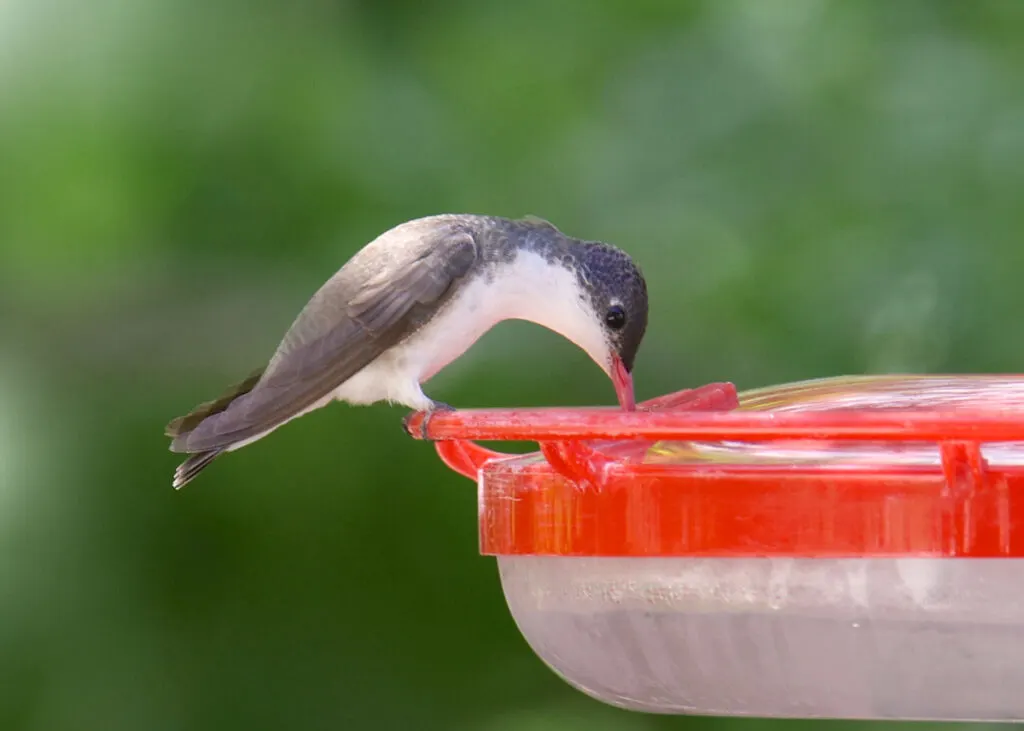
- Weight: 0.18 – 0.20oz
- Distribution: Mexico and the extreme southwestern United States
- Habitat: A varied landscape that can include parks, gardens, forests, fields, and orchards
- Diet: Nectar and insects. It will take nectar from a wide variety of flowering plants—also visits hummingbird feeders.
The violet-crowned hummingbird is a regal-looking little bird. It sports a purple crown that contrasts sharply with its bright orange bill and white throat/belly.
Both sexes are almost identical, although female coloration is sometimes less intense.
Although violet-crowned hummingbirds only nest in North America during mid to later summer, further south, they can breed throughout the year.
This type of hummingbird is a regular visitor in southern Arizona and New Mexico, but they are not abundant in these regions.
Violet-crowns usually nest in deciduous trees or shrubs, but not much is known about the breeding behavior of these beautiful birds. When flowers are scarce, they rely on catching small insects.
11. Xantus’s Hummingbird
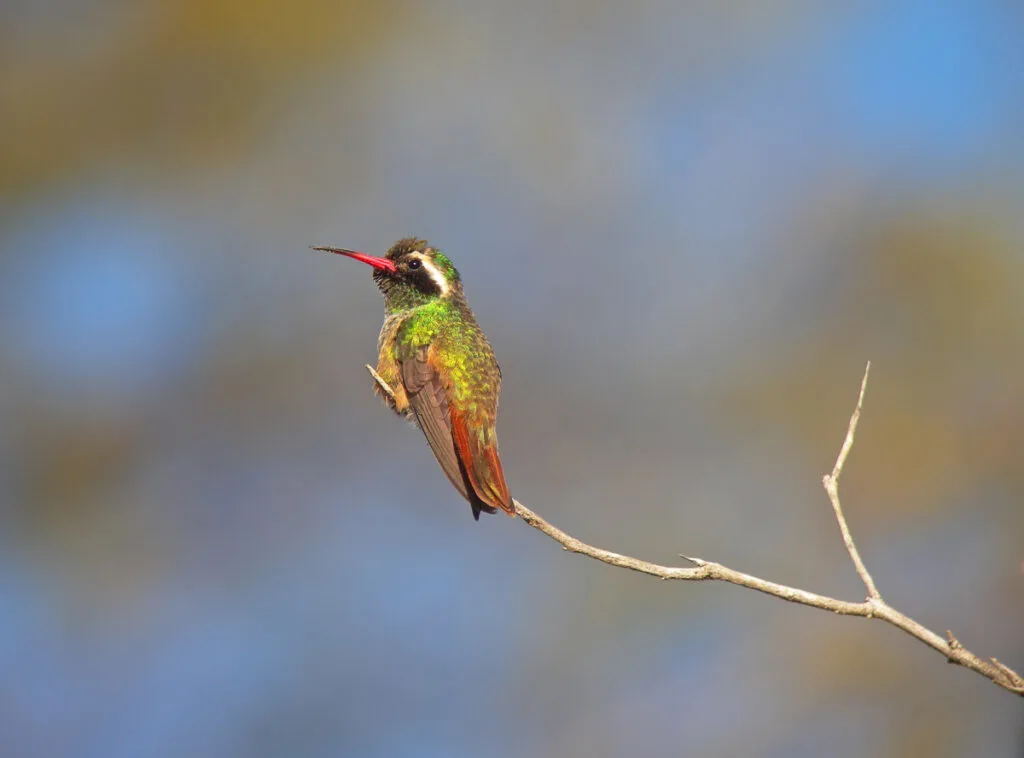
- Weight: 0.12 oz
- Distribution: Baja California Peninsula
- Habitat: Woodlands and scrub of elevations of between 490 and 4900ft. They are also visitors in gardens, coastal desert regions and can be seen at hummingbird feeders.
- Diet: Nectar from a variety of plants. It also catches small insects.
The distinctive white stripe behind the ear is a clue that Xantus’s hummingbird is a relation to the white-eared hummingbird. They were previously called black-fronted hummingbirds.
The blackness of the male Xantus’s hummingbird is actually just dark feathering that appears black.
It has a deep green shimmer in the light and bright orange bills with a black tip. Females have cinnamon color underparts and a duller color bill.
Although Xantus’s hummingbird is endemic to a specific region, vagrants have been found as far afield as British Columbia.
This type of hummingbird’s movement patterns is yet to be fully documented.
12. Rivoli’s Hummingbird
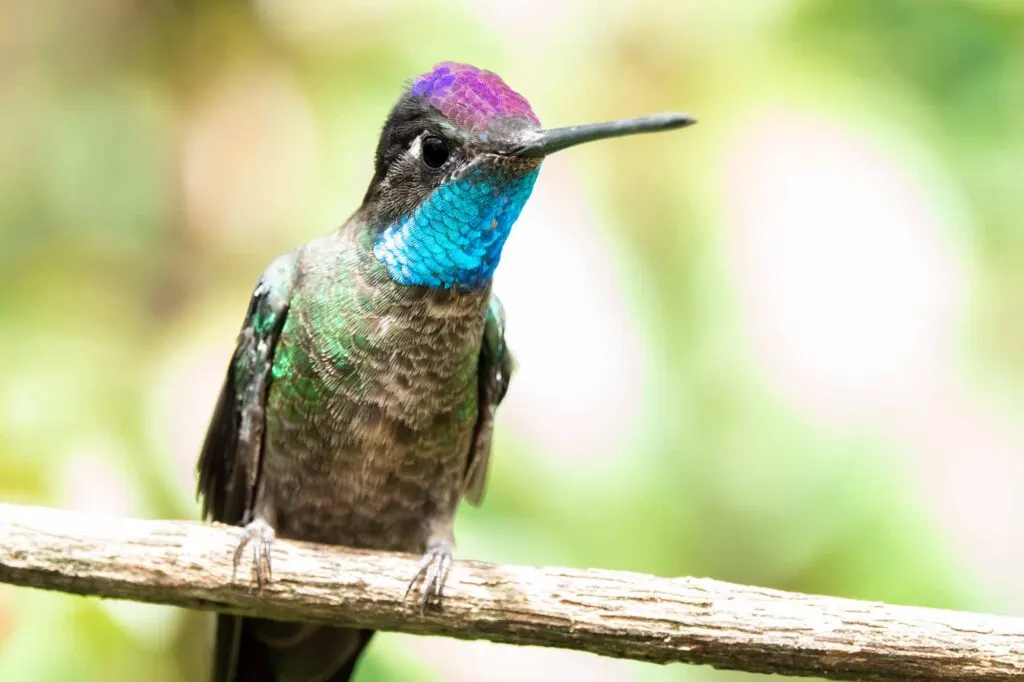
- Weight: 0.21 – 0.35oz – Males are slightly larger than females
- Distribution: Southwestern United States to Honduras and Nicaragua
- Habitat: A high-altitude dweller that prefers habitats from 4900ft. Often found in and around pine forests.
- Diet: Nectar from various flowering plants. Rivoli’s hummingbird consumes more insects than many other types of hummingbirds.
Rivoli’s hummingbirds were previously called magnificent hummingbirds.
They are spectacularly pretty birds with dark plumage that catches the light to show off shimmering flashes of color.
The long-billed Rivoli’s hummingbird is noticeably larger than many other types of hummingbirds.
Even when it is flying, it appears considerably slower than some of its relatives, and you may even be able to see the movement of its wings.
If you live in an area where Rivoli’s hummingbirds occur, you can attract them to your garden by putting out a hummingbird feeder.
They are also keen insect hunters and will even steal bugs caught in spider webs and eat the spider too.
13. Rufous Hummingbird
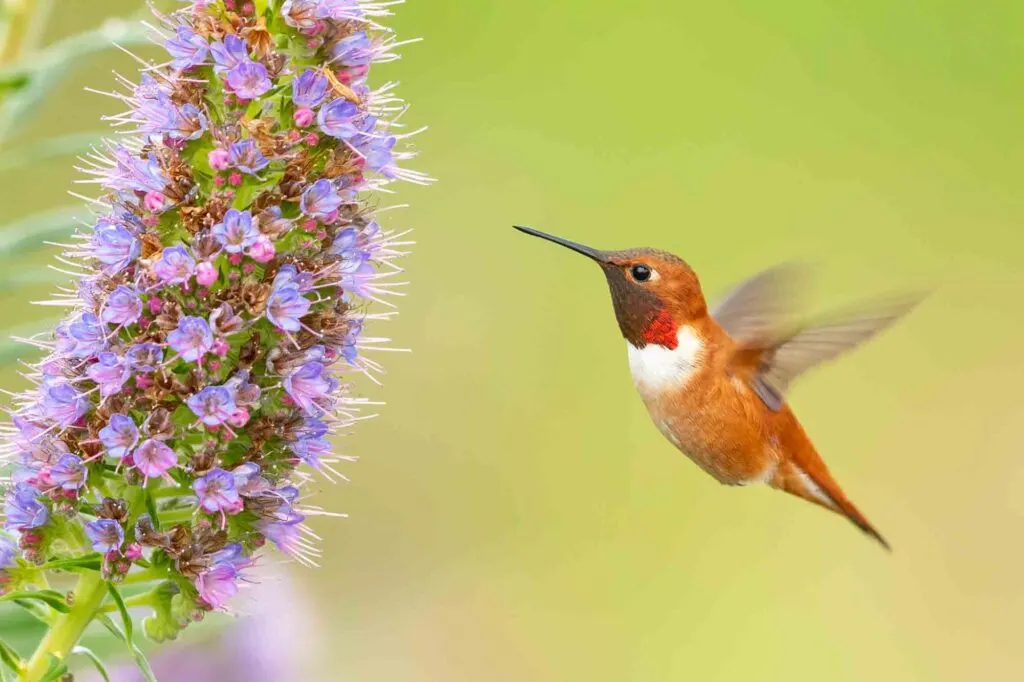
- Weight: 0.1-0.2 oz
- Distribution: Moves between the Rocky Mountain areas of the United States and south-central Mexico.
- Habitat: Wooded areas. They are migratory, so they may stop in a variety of habitats en route between summer and winter grounds.
- Diet: Nectar and small insects
Rufous hummingbirds are true acrobats of the skies. They dart about and move quickly with the distinctive hummingbird style of weightless hovering.
Male rufous hummingbirds look like tiny shimmering embers. They are mostly bright orange, while females may only show a hint of the flamboyant orange coloring on their throats. They are mainly a more demure shade of green.
Although rufous hummingbirds are still common species within their range, their numbers are in decline due to climate change. They are sensitive to specific conditions, which makes them particularly vulnerable.
Look out for these cheeky little hummers at your feeder if you live in an area where rufous hummingbirds spend their summers or along their migratory path.
They are likely to chase off other hummingbirds, even if they are just stopping for a break.
14. Ruby-Throated Hummingbird
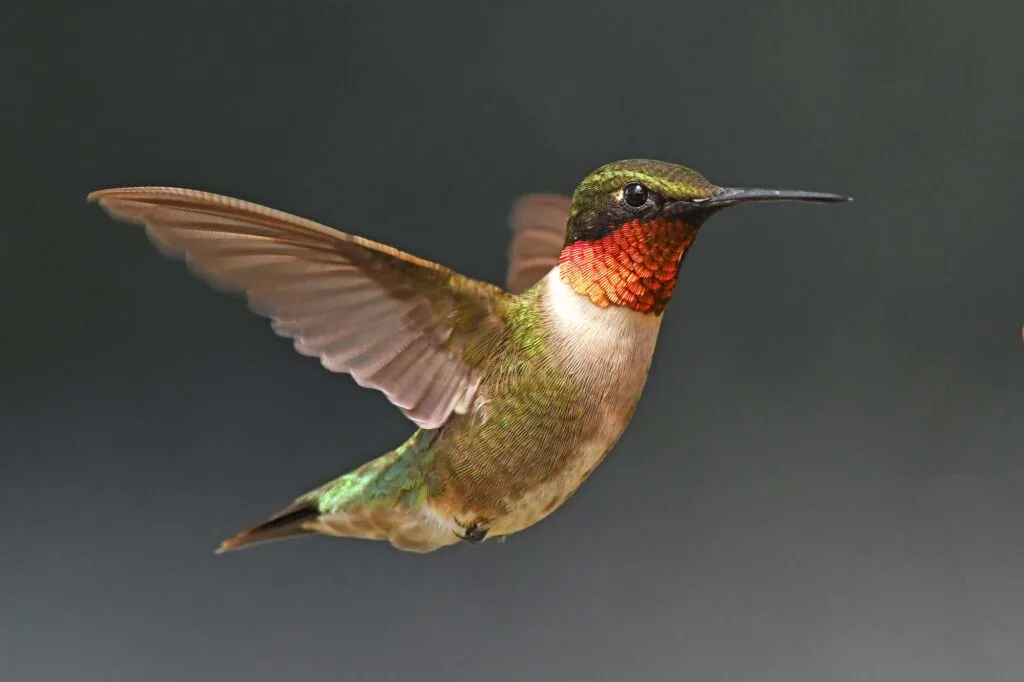
- Weight: Average weights: Males – 0.12oz and females 0.13oz
- Distribution: Summer range is Eastern United States and southeastern Canada. Winters in Florida, Mexico, or Central America
- Habitat: Open woodlands and brushy habitats
- Diet: Nectar from a variety of sources and insects. They prefer bright red, orange, or pink blossoms
Like many types of hummingbirds, ruby-throated hummingbirds are sexually dimorphic. That means that the males and females of the same species look very different from each other.
Males have a bright red throat which is entirely absent in females. They also have green backs and forked tails with no white. Both sexes molt once a year during the winter season.
It is almost impossible to tell female ruby-throated hummingbirds apart from black-chinned hummingbirds.
The only real way to tell is that their range is different, so you need to know exactly where you are to be able to positively identify one or the other.
The oldest recorded ruby-throated hummingbird was nine years and two months old when it was caught and released for a second time during routine banding.
They will readily come to backyard feeders throughout their range and are the most commonly found hummingbirds in eastern North America.
15. Mexican Violetear
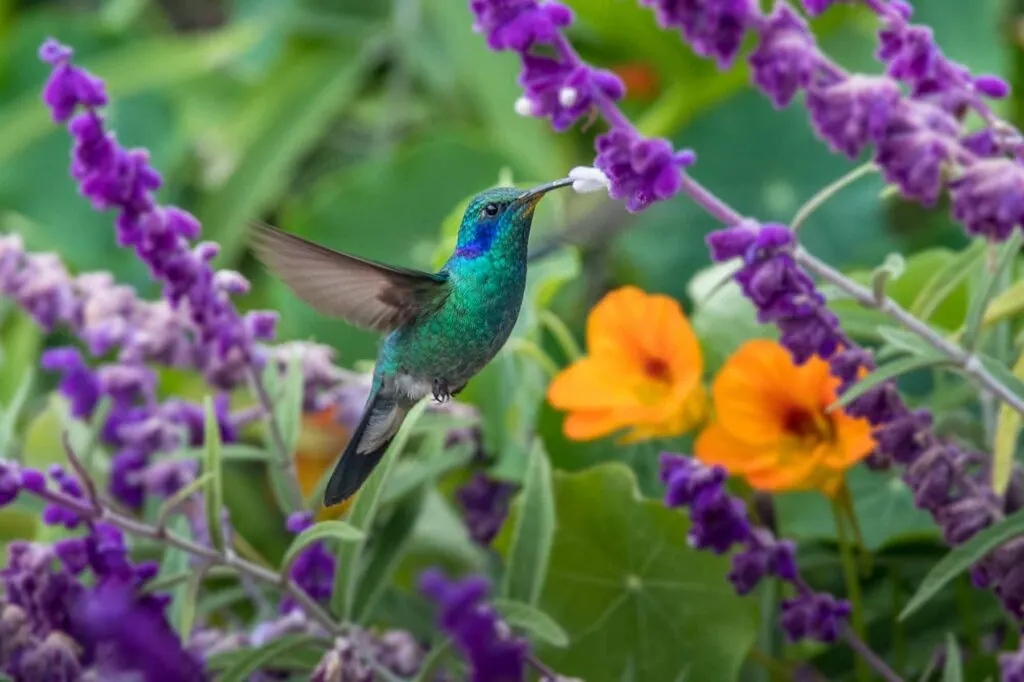
- Weight: 0.17 – 0.20oz
- Distribution: Mexico to Nicaragua
- Habitat: Forested areas, especially clearings and near the edges of forests
- Diet: Nectar and insects. They prefer flowering trees over plants that flower on the ground.
The Mexican violetear is an average-sized hummingbird with a straight black bill. It has eye-catching violet color ear-patches, and male and female hummingbirds are identical.
A unique characteristic of these hummingbirds is that they prefer to feed at the mid-canopy level.
They are most attracted to tropical flowering trees than meadows or garden flowers. In fact, it isn’t easy to see them feeding at all because they tend to stay in the shaded areas in trees.
Although you won’t commonly see these glittery types of hummingbirds in North America, they do occasionally stray into Texas. A few vagrants have been recorded as far north as the southern border of Canada.
16. Broad-Billed Hummingbird

- Weight: Average weight: males – 0.125oz and females – 0.1oz
- Distribution: Northwestern Mexico and extreme southern parts of the United States
- Habitat: Canyons, riparian woodland, and thorn forests
- Diet: Nectar and insects
Male and female broad-billed hummingbirds look so different that they hardly seem related.
The males are a deep bottle green with rich blue throats. Over time their black-tipped bills become bright red.
Female broad-billed hummingbirds have pale throats and bellies. They also have a distinctive white eye stripe which is entirely absent in males of this hummingbird species.
Juvenile broad-billed hummingbirds resemble the female until they mature.
A courting flight of male broad-billed hummingbirds is unique. When it is trying to impress a potential mate, they fly back and forth in front of the female.
This behavior is referred to as a pendulum display, as it is reminiscent of a hypnotist’s pendulum.
Broad-billed hummingbirds occasionally venture into the southern regions of the United States and are ready visitors to hummingbird feeders they come across.
They prefer red or red and yellow feeders.
17. Crowned Woodnymph
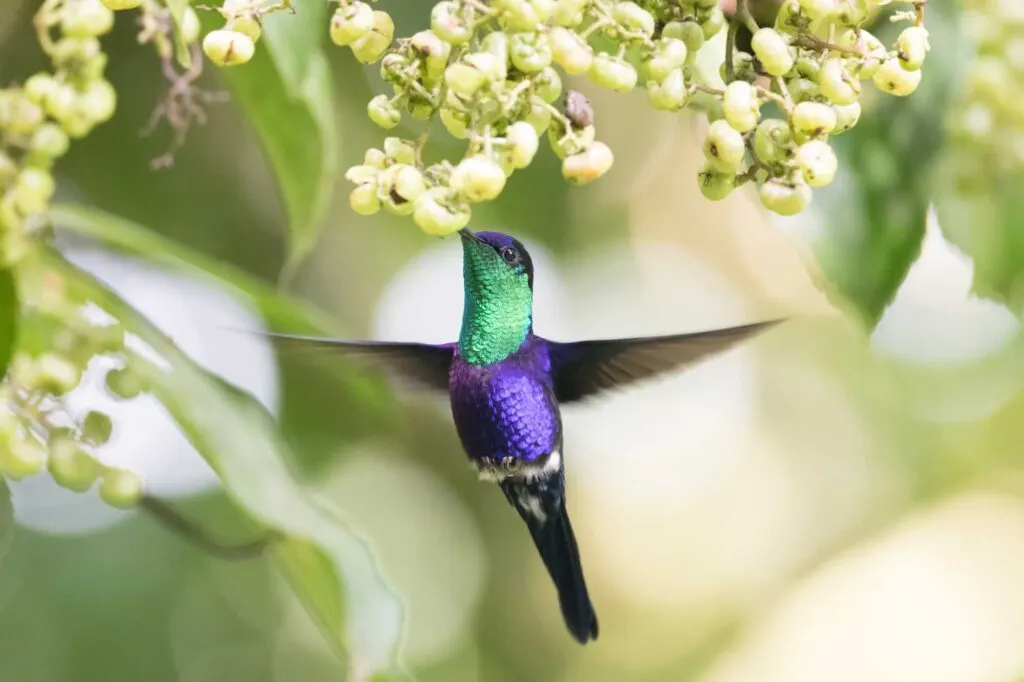
- Weight: 0.12 – 0.15 oz
- Distribution: Belize through to northern Peru
- Habitat: Edges of evergreen forests. Usually near streams.
- Diet: Nectar of flowering plants – seldom feeds from high trees.
The crowned woodnymph is also often called the violet-crowned woodnymph. Even though it doesn’t have the word hummingbird in its name, it is an unmissable gem in the Trochilidae family of beauties.
There are a few recognized subspecies of crowned woodnymph, which include vibrant names like emerald-bellied woodnymphs and northern violet-crowned woodnymphs.
Colors vary between the subspecies, but males are usually rich tapestries of deep greens, violets, and blues, while females are less flashy.
Both male and female crowned woodnymphs defend nectar-rich territories. Females have been noted to be more aggressive about protecting their preferred spots than males.
18. Crimson Topaz
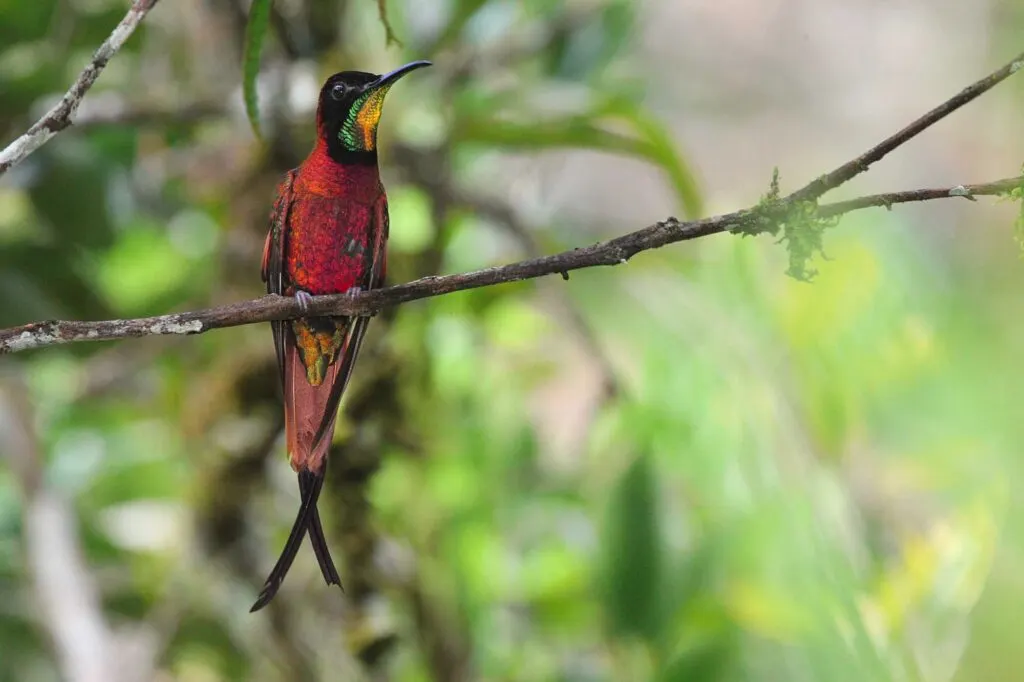
- Weight: Males: 0.39 – 0.63 oz, and females are 0.32 – 0.44oz
- Distribution: Pockets of this species of hummingbirds are found in Brazil, Suriname, Venezuela, French Guiana, and Guyana.
- Habitat: Inland rainforests below 1600ft
- Diet: Nectar and insects
You would need to travel to South America to see a crimson topaz in its natural environment, but the trip would definitely be worth the while!
They are a close second in size to their cousins, the giant hummingbirds, which are the largest type of hummingbird.
It is not only their large size that makes a crimson topaz hummingbird stand out.
The undersides of male birds are bright red, and the upper feathers are a blend of bronzes and golds. Another distinguishing feature is their long crisscross tail feathers.
Females are mostly green, but they may have a touch of the distinctive crimson color that these types of hummingbirds are known for.
They have black heads, and the bills of both sexes are long and slightly curved.
Crimson topazes are very similar to another type of hummingbird called a fiery topaz.
To make things even more confusing, the two species can breed together, which makes the distinction between the two hummingbird types even less clear for birdwatchers.
FAQ About Hummingbirds Types
How many types of hummingbirds are there?
There are more than 360 different types of hummingbirds described by scientists.
What is a hummingbird?
Hummingbirds belong to a large avian family called Trochilidae. They are tiny birds known for their fast wing flapping and vibrant colors.
What are some common characteristics of hummingbirds?
Hummingbirds are native to the Americas and are the smallest birds on Earth. They have minuscule eggs and can hover in mid-air by using the up and down strokes of their wings. They also feed on nectar and small insects.
How are hummingbirds divided into subfamilies?
Hummingbirds are divided into six subfamilies: Florisuginae, Phaethornithinae, Polytminae, Lesbiinae, Patagoninae, and Trochilinae.
Can hummingbirds be found in the United States?
While only a few species of hummingbirds live in or visit the United States, they are more common in Central and South America.
What are some types of hummingbirds in the Florisuginae subfamily?
The Florisuginae subfamily includes species such as the crimson topaz, fiery topaz, white-necked, and black jacobins.
What are some types of hummingbirds in the Phaethornithinae subfamily?
The Phaethornithinae subfamily includes 37 types of hummingbirds known as hermits.
What are some types of hummingbirds in the Polytminae subfamily?
The Polytminae subfamily includes 29 species known as mangoes, primarily found in tropical jungles of South America.
What are some types of hummingbirds in the Lesbiinae subfamily?
The Lesbiinae subfamily includes 33 hummingbird types divided into two groups called brilliants and coquettes.
What is the largest hummingbird species?
The giant hummingbird, found in western South America, is the largest member of the hummingbird family. Despite being the largest, it only weighs around 0.7 ounces.
What is a group of hummingbirds called?
A group of hummingbirds is called a charm or a bouquet of hummingbirds.
Where can I find specific types of hummingbirds?
The distribution and habitat of each type of hummingbird vary a lot. Some are found only in specific regions, such as the bee hummingbird in Cuba or the Costa’s hummingbird in the southwest United States and northwest Mexico. Consult the article for more information on each type’s distribution and habitat.
What do hummingbirds eat?
Hummingbirds primarily feed on nectar from flowers, but they also consume small insects and spiders to feed their young.
Can I attract hummingbirds to my area?
Yes, attracting fruit flies and providing a suitable environment with nectar-rich flowers and feeders can help support different types of hummingbirds in your area.
Hey you! Did you enjoy learning about these incredible types of hummingbirds? Then share these colorful birds with your friends on social media!
Summary of 18 Different Types of Hummingbirds
1. Bee Hummingbird
2. Costa’s Hummingbird
3. Buff-Bellied Hummingbird
4. Blue-Throated Hummingbird
5. Anna’s Hummingbird
6. Giant Hummingbird
7. Calliope Hummingbird
8. Brazilian Ruby Hummingbird
9. White-Eared Hummingbird
10. Violet-Crowned Hummingbird
11. Xantus’s Hummingbird
12. Rivoli’s Hummingbird
13. Rufous Hummingbird
14. Ruby-Throated Hummingbird
15. Mexican Violetear
16. Broad-Billed Hummingbird
17. Crowned Woodnymph
18. Crimson Topaz
